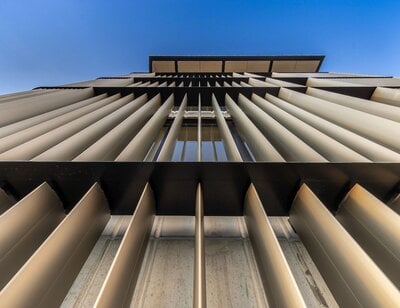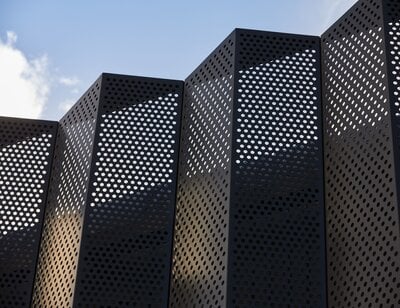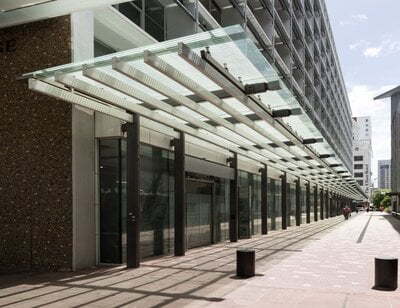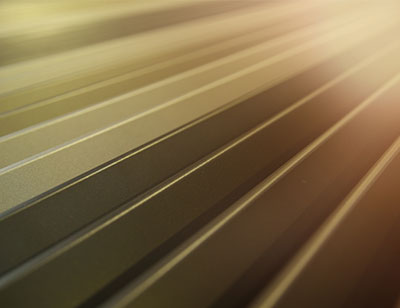When Napoleon sat down with guest for a large banquet, they dined using cutlery crafted from gold. All except the most honourable guest that is. They dined with cutlery that was worth so much more. It was a way to recognise their importance and standing at the dinner table. They were given aluminium cutlery. We can only image what those dinner guests would think if miraculously transported to today and able to stand in front of Burwood Hospital in Christchurch, to stare up at a structure adorned with around 60 tons of aluminium. That said, it's possible they wouldn't even recognise the use of aluminium in many places. It might appear as wood, stone or concrete. It might even be bright pink, pale blue or even golden.
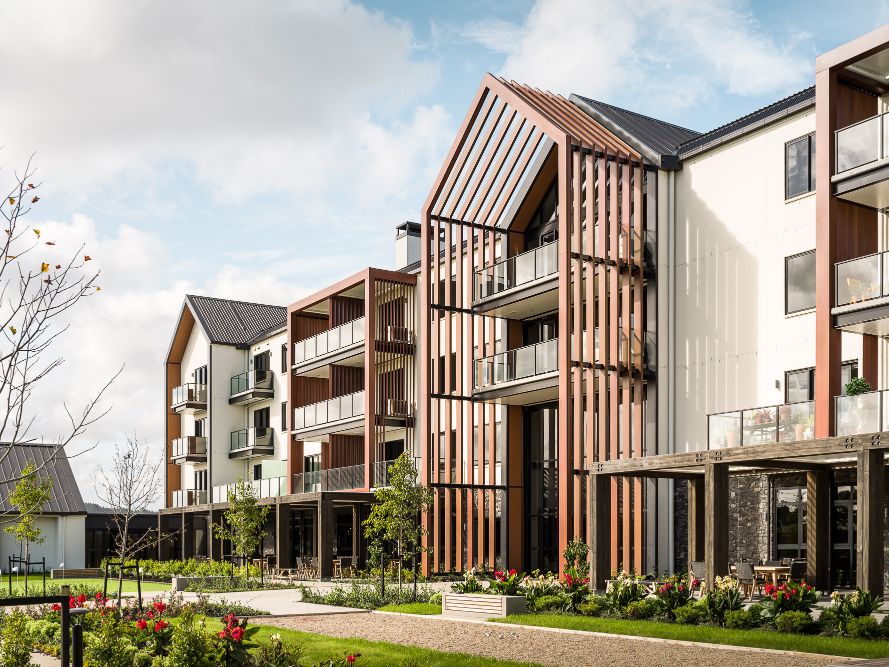
The popularity of aluminium as a facade choice is, in part, in its ability to change its finished appearance into almost anything. An undisputed chameleon of the facade world, it can take on virtually any shape and appearance. What follows is an overview of the available finishing options, the process required, benefits delivered and how to keep it looking great.
Anodised Aluminium
Anodising is the methodology used to change the surface chemistry of metals and other substrates. With aluminium, the result is a decorative and protective film of aluminium oxide, which is built up on the surface.
It has been around since the early 1920's and was first used to protect seaplane parts from corrosion. As an interesting aside, aluminium relationships with planes dates back to the very first plane, the Wright Flyer, Orville and Wilbur Wright using aluminium for parts of them motor in the interest of keeping weight down.
The most significant patent for the process, being the methodology used today involving sulpheric acid, was issued in 1927 to the British pair of Gower and O'Brien.
The Anodising Process
Thoroughly cleaned aluminium is placed into a bath of electrolytic solution (an electrical solution with lots of positive and negative ions). Most commonly in New Zealand, this solution is sulpheric acid (as per the patented process by Gower & O'Brien). Aluminium sheet cathodes are then added to the solution, followed by the article for anodising, which has a positive charge applied, thus making it the anode. This causes a reaction whereby the sulpheric acid begins to decompose. Hydrogen ions move to the cathode and change form into hydrogen gas. Meanwhile, aluminium ions move towards the cathode but are met at the anode surface by oxide/hydroxide ions, forming aluminium oxide, which acts as a barrier layer.
Applying a higher voltage for a prolonged period of time will continue the growth of this layer beyond the initial barrier layer. Competing anodising and acid solution processes cause an open, pore-like structure with a depth measured in microns. It should be noted, Aluminium oxide is rated 9 out of 10 on the Moh Hardness Scale (10 being a diamond).
10 Microns: Suitable for internal (or sheltered) applications, or those where frequent cleaning is expected.
15 Microns: Suitable for the majority of architectural requirements.
25 Microns: Recommended for heavy duty external applications where there is little tolerance for deterioration.
The Benefits of Anodised Aluminium
There is an undeniable appeal to the characteristic anodised aluminium sheen. The visual benefits are also enduring, with the durability of anodised aluminium being quite remarkable.
That wonderful sheen is highly resistant to scratches and cracking, so will continue to look at its best for a considerable time if well maintained. The same barrier layer that produces the sheen also creates corrosion resistance, further reinforcing the longevity of aluminium's aesthetic appeal.
When a coloured finish is desired, that colour will not peel or otherwise diminish. The secret is in the process which embedded the colour deep into the pores before sealing is completed, where the anodised article is placed in hot water for specified period of time. Pigment dyes can be used but the majority of coloured finishes are achieved using an electrolyte colouring, as it tends to produce a more uniform finish and is easily replicated for consistency.
The Care and Maintenance of Anodised Aluminium
Nothing is completely maintenance free, so despite the noteworthy durability of anodised aluminium, some care and upkeep is required. Regular cleaning of the surface is required to stop grime build up. If you allow grime to accumulate it will absorb any contaminated moisture, then store it against the anodised surface. Over time, this could lead to irreversible damage as the barrier layer eventually becomes compromised.
Just how frequently you have to clean the surface is really dependent on the environment. Harsher environments, such as in coastal or heavy industrial areas will pose an elevated risk. So they require a more frequent cleaning schedule. Cleaning the surfaces once every 3 months should suffice, whereas every 6 months may be ok elsewhere. It would be hard to over clean the, so we recommend always erring on the side of caution when it comes to cleaning frequency.
As regards cleaning methodology, it's pretty mcuh the same as for cleaning windows and using similar material is ok. Be sure to avoid the use of abrasive cleaners as these can damage the surface. If a more intense cleaning is requried for particularly stubborn areas, then only methylated spirits or isopropyl alcohol should be used. Nothing else.
Aluminium Finishes: Standard Powder Coating
The most widespread finishing option is powder coating. One of the reasons powder coating is used is the wide colour gamut, along with the opportunity to create a custom colour if you can't find that perfect hue for your design. As to the powder coating itself, it's a dry finishing process where electrically charged particles are sprayed onto the surface of the pre-treated aluminium. After application, the sprayed coating is cured under heat, providing an optical enhancement and increased lifespan.
With powder coating, you get a high quality finish that resistant to impact from chemicals, moisture, ultraviolet rays and extreme weather conditions. It also has a reduced risk of scratching, chipping, corrosion, abrasions, fading or other wear issues.
To keep the integrity of a powder coated finish, a cleaning frequency of quarterly (i.e. once every 3 months) should prove sufficient to combat the accumulation of grime, dirt and other atmospheric pollutants. In locations where these pollutants may be more prevalent, such as industrial areas or in close proximity to the ocean, a more regular maintenance program with cleaning completed every month or second month, should be set.
To clean powder coated aluminium, first remove an y loose surface deposits with a wet sponge. Next, take a soft brush (non-abrasive) and a diluted solution of mild detergent such as liquid dish washing detergent and warm water, and use it to remove more stubborn particles and deposits. Finally, thoroughly rinse with clean water.
As with anodised aluminium, never use abrasive cleaners as these may cause irreversible damage to the colour and surface, resulting gloss loss within a truncated period of time. The only cleaning products recommended are methylated spirits and isopropoyl alcohol. All others should be avoided.
Aluminium Finishes: Woodgrain Sublimated powder coat
Advancements in finishing techniques can effectively transform the appearance of aluminium into something else. For example, the main entrance of the Country Club Huapai features large wood grain louvres. Unless you stand next to them and feel them, you'd be hard pressed to identify them as aluminium, which has a strength to weight ratio which is 43 times higher than wood. The other big advantage is aluminium being classified non-combustible and Group 1 compliant.
The incredible effect is achieved through a complicated process called sublimation where a base layer of powder coat is applied to the aluminum then an actual wood grain image is printed into (rather than onto) the powder coat base layer. Sublimation is the process of going from a solid to a gas, then back to solid, skipping the liquid state. For the sublimation of the wood grain finish on aluminium, a high definition image of a natural wood grain is moved into position on the powder coated extrusion by vacuum suction. The film and extrusion are then placed into a specifically designed heat press like machine, which reaches temperatures of up to 200 degrees. When subjected to extreme heat and pressure, the dyes from the image are transformed into a gas which is forced beneath the base powder coat layer. There, they settle and solidify. Once the extrusion is removed from the press and the extrusion cools, the woodgrain images are permanently embedded. The result is impressive and permanent.
By mixing the warmth and aesthetics of a natural woodgrain and durability of Aluminium, it's easy to see the appeal of a woodgrain finish. Any type of natural woodgrain is achievable, including those from scarier varieties of wood which are not easily available and are best left to grow in nature, rather than be harvested. Also, there are no Volatile Organic Compounds (VOC's) released in the atmosphere due to the use of water based dyes, making it an Eco friendly process. A woodgrain finish is also fully customisable, whereas real wood designs are often complicated by the grain.
As the dyes are embedded into the powder coated extrusion, the care and maintenance required is the same as that of powder coated aluminium extrusions. As regards maintenance intervals, three monthly is recommended unless in a marine or industrial environment, where as increased frequency is desirable. A cleaning interval of 6 months in normal conditions should be considered the absolute maximum.
Other Sublimated Aluminium Finishes
Finishing possibilities extend way beyond a woodgrain effect. Maybe the facade calls for a rusted look, adding some artificial ageing to a building design to support some historical context or back story. Or maybe the architectural vision calls for a brushed steel look (but without the expense). There are a number of material finishes available, including titanium and zinc. All are completed via the same previously described sublimation process necessary for the woodgrain finish.
For a distinguished and classical look, a marble finish is offered. As a material, whilst it looks desirable, marble is not particularly well suited to colder climates. There is also a tendency of marble to stain and scratch with relative ease (when compared to other stones). It makes an aluminium facade with a marble finish particularly appealing. We suspect such an approach also provides a significant cost advantage.
Finally, there's a certain industrial aesthetic derived from concrete which has appeal. Yet concrete suffers from a low tensile strength and propensity for cracking. Adding a white, grey or black concrete powder coated finish on aluminium negates both of the aforementioned disadvantages. Yet the same industrial aesthetic is achievable.
To Finish on Finishes
This is difficult as there isn't really any way to finish talking about finishes, when the possibilities are unfinished. The seemingly endless array of opportunities is exactly what makes aluminium such an ideal base for any type of facade... even wood, titanium and concrete ones. We can shape and form to realise any design imagined (pretty much and we;re open to the challenge of being proved wrong) and then change the exterior of that design to deliver the perception of it being made of something else.
Ok. Finished now.

